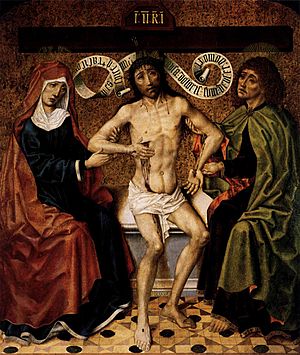Diego de la Cruz (painter) facts for kids

Diego de la Cruz was a Spanish painter who lived a long time ago, around the late 1400s (from about 1482 to 1500). He might have come from Flanders (a region in Europe known for its art). He worked mostly in the city of Burgos, Spain, and the areas nearby.
Contents
A Forgotten Artist Rediscovered
For many years, Diego de la Cruz was an artist that people had forgotten about. But in 1966, a special study helped bring his work back into the spotlight. This study suggested that he was born in Flanders around 1460. It also thought he came to Spain before other famous Flemish painters arrived.
Where Was He From?
Some art experts believe Diego de la Cruz was born in Flanders. They think he moved to Spain early in his life. However, other experts believe he was born in Spain, perhaps in a region called Castile.
No matter where he was born, his art shows a strong influence from painters in the Burgundian Netherlands. These artists were known for their unique way of using light in paintings. This style might have come from his own background or from other Flemish artists who were working in Spain at the time. Some even think he might have started as a sculptor. He may have learned his skills in the workshop of Gil de Siloé, who was also thought to be from Flanders.
His Most Famous Works
We know a lot about Diego de la Cruz's painting style from two very important artworks. One is called Cristo de Varón de Dolores entre la Virgen y San Juan. This painting is special because it's the only one he signed! You can see it at the Museo del Prado in Spain. He likely painted it between 1475 and 1480.
The other key painting is the Estigmatización de San Francisco de Asís. This artwork is located in the Church of San Esteban in Burgos. He painted this one a bit later, between 1487 and 1489.
Other Paintings by Diego de la Cruz
By carefully studying these two main works, art experts have been able to guess that other paintings were also made by Diego de la Cruz. Some of these include:
- Cristo de Piedad entre dos ángeles: This painting can be found in the Colegiata de Covarrubias.
- Cristo de Piedad entre los profetas David y Jeremías: This was the middle part of a larger altarpiece. Two other parts of this altarpiece, showing the prophets Isaiah and Daniel, are now in a collection at the University of Liège.
These paintings help us understand more about Diego de la Cruz and his unique artistic style.
See also
 In Spanish: Diego de la Cruz para niños
In Spanish: Diego de la Cruz para niños

